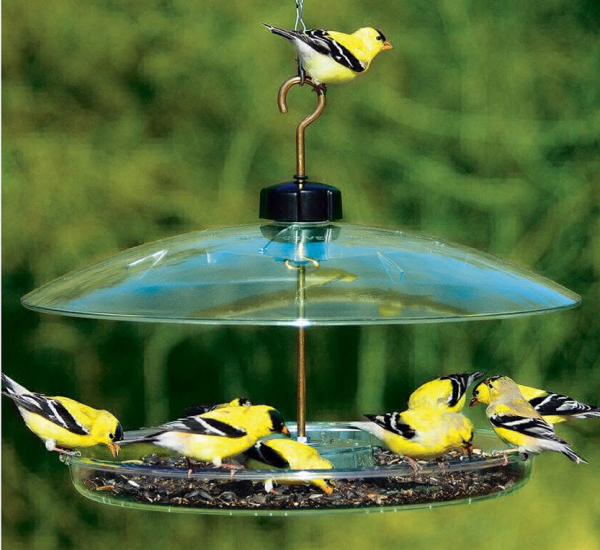
Platform Feeder – the Droll Yankees Covered Platform Bird Feeder
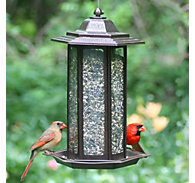
Hopper Feeder – the Perky-Pet Tall Tulip Garden Lantern Feeder
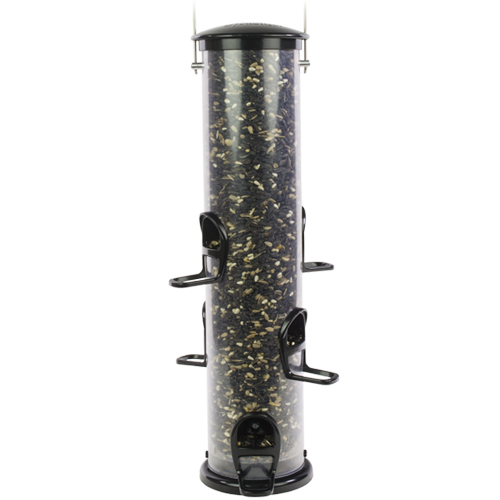
Tube Feeder – the Wild Birds Unlimited EcoClean Extra Large Seed Tube Feeder
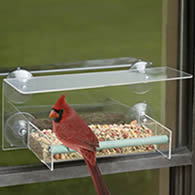
Window Feeder – the Duncraft Window-Safe Window Wonder Feeder
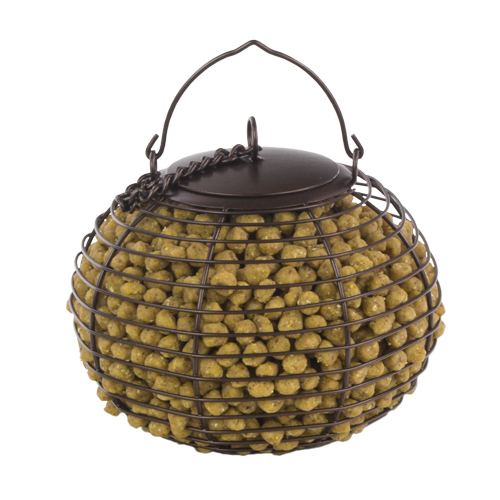
Peanut Feeder – the Wild Birds Unlimited Peanutball Feeder
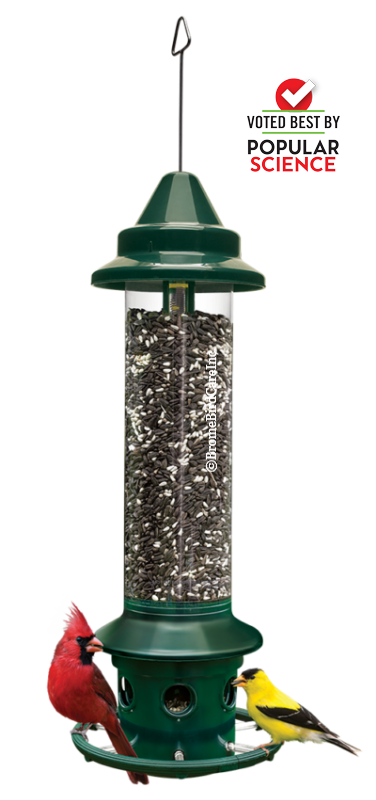
Squirrel-Proof Feeder – the Brome SquirrelBuster Plus Feeder
|
When you take a look at the stock of seed feeders offered by some companies, you might get the impression that there is an infinite number of different wild bird seed feeders available – different styles, different colors, different sizes, different feeders for different foods and for different kinds of birds. There are a lot of options, but essentially all bird feeders fall into five basic feeders – platform, hopper, tube, peanut, and window feeders. There is also a subset of squirrel-proof feeders that essentially protect a tube feeder or hopper feeder from marauding squirrels. Let’s take a closer look at the variety of seed feeders.
* Platform Feeders – The most basic style of feeder, as well as a very popular feeder type, platform feeders are usually a simple tray, usually mounted on a pole or another elevated location, or fastened as a hanging feeder. Platform feeders tend to have the least sanitation among feeder types when seed shells and bird fecal material accumulate, so they need regular (daily) service to keep them clean and healthy places for birds to visit. Some platform feeders have a roof cover to keep precipitation out and provide a shaded feeding area. Platform feeders should also have ample holes for drainage so water does not accumulate or pool in the open tray.
* Hopper Feeders – One of the most traditional feeders, the hopper feeders “seed bin” is easy to fill by removing the top and seeds filter downward via gravity. They usually have a roof that protects seeds and feeding birds. Hopper feeders are usually either hung or pole mounted, and their perching areas are more sanitary than an open platform feeder with less of a chance that birds can mute among the seeds, and less chances for seed shells to accumulate. Hopper feeders offer a broad diversity of styles, and many are very attractive and provide personalized options.
* Tube Feeders – Well-named, tube feeders are usually a cylinder made of clear hard plastic, although sometimes they are made of metal or glass. The cylinder has a varied number of feeding ports (holes) with associated perches, depending on the particular model. Tube feeders are usually filled and cleaned from a removable top, and seeds funnel downward from the top. Tube feeders may be the most sanitary feeders because seed shells and fecal material drops below the feeder, although the area below the feeder will need regular clean-ups.
* Window Feeders – Usually modeled as a smaller light-weight version of a platform feeder and fitted with suction cups to hold the feeder in position on the window of your choice. Often made of see-through hard plastic and fitted with a clear roof cover to protect the seeds, these specialty feeders provide great close-up views of birds, which is fun for children and adults alike.
* Peanut Feeders – Peanut feeders are available for shelled and unshelled peanuts, and while the relatively large mesh container holds the peanuts in position, the mesh holes are large enough for birds to extract the peanuts without much of an effort. Shelled peanuts will obviously provide more of a “mess,” although birds often grab a peanut and feed on it in another location, which tends to spread the mess around.
* Squirrel-Proof Feeders – While you can try to keep squirrels away from feeders by using squirrel baffles on pole-mounted or hanging feeders, there is an assortment of very useful squirrel-proof feeders on the market that utilize on of a number of ways of preventing squirrels from accessing the feeder, or the food within. Some models are essentially caged with wire mesh surrounding the feeder, which permits smaller birds inside the “cage” to feed, while keeping squirrels and some larger birds from the seeds. Other squirrel-proof feeder options include a spring system that closes feeding ports when a squirrel puts its weight on the feeder, and there are other technologies being utilized in the variety of models on the market.
We have selected an example of each type of seed feeder to illustrate one of many, many different models of each feeder type, so don’t hesitate to do some shopping, at your local wild bird store or on-line at the top feeder companies to find a feeder or feeders that will serve you and your birds in the coming months and years.
Seed feeders are often the centerpieces of our feeding stations, and as we enter the mid-fall season, the weather reminds us that a variety of seed-eating birds will be arriving soon – possibly tomorrow – as they migrate south to join the seed eaters already on hand. Which models of seed feeders fit your interests best? Will a combination of more than one suit your feeding station in the best ways? It’s an exciting time of the year for birders as we become more home-oriented as winter approaches and seed-eating birds become a growing feature of our yards.
Share your backyard birding experiences and photos at editorstbw2@gmail.com